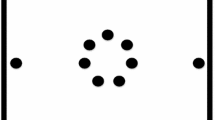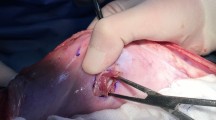Abstract
Purpose
In laparoscopic ventral hernia repair, parietal ingrowth of the mesh is of crucial importance. Until significant ingrowth occurs integrity of the repair depends solely on mesh overlap and anchoring device. Relatively few studies have addressed the effect of mesh properties and anchoring device on long-term parietal ingrowth.
Methods
In 20 sheep, using laparoscopy, we inserted two different polypropylene-based meshes, Physiomesh™ and Ventralight™ ST, anchored with Protack™, SecureStrap™, or Glubran™. After 6 and 12 months, 10 sheep at each time point were euthanized, and we harvested the meshes with corresponding fascia. Mesh with fascia was attached on an Alwetron™ materials testing machine and pulled apart obtaining the peel-off energy (kilojoule (kJ)).
Results
The strength of parietal ingrowth at 6 months was 5.99 ± 0.54 kJ (mean ± SEM), 4.94 ± 0.54 kJ and 7.35 ± 0.55 kJ when anchored with Protack™, Glubran™, or SecureStrap™, respectively. At 6 months, the strength of parietal ingrowth of SecureStrap™ was significantly higher than Glubran™ (p = 0.04). No significant difference was seen between any other combinations. Parietal ingrowth at 12 months was 7.05 ± 0.56 kJ, 7.55 ± 0.54 kJ, and 5.73 ± 0.54 kJ when anchored with Protack™, Glubran™, and SecureStrap™, respectively. No significant difference in strength of parietal ingrowth was seen between the three types of anchoring, (p = 1.00, p = 1.00, and p = 0.29).
Conclusions
At 12 months, the strength of parietal ingrowth was the same for all comparisons. The two polypropylene meshes showed equal strength of parietal ingrowth independent of mesh properties and anchoring devices used.




Similar content being viewed by others
References
LeBlanc K (2016) Proper mesh overlap is a key determinant in hernia recurrence following laparoscopic ventral and incisional hernia repair. Hernia. Our Lady of the Lake Physician Group, 7777 Hennessy Blvd. Suite 612, Baton Rouge, LA, 70808, USA. karl.leblanc@ololrmc.com 20:85–99
Morales-Conde S, Barranco A, Socas M, Alarcon I, Grau M, Casado MA (2011) Systematic review of the use of fibrin sealant in abdominal-wall repair surgery. Hernia. Morales-Conde, S., Advanced Laparoscopic Unit, University Hospital Virgen Del Rocio, Seville 41010, Spain 15:361–369
Harslof SS, Wara P, Friis-Andersen H (2014) Fixation devices in laparoscopic ventral hernia repair: a review. Surg Technol Int. Surgical Department Regional Hospital Horsens Horsens, Denmark.; Surgical Department Aarhus University Hospital, THG Aarhus, Denmark.; Surgical Department Regional Hospital Horsens Horsens, Denmark 24:203–213
Chelala E, Barake H, Estievenart J, Dessily M, Charara F, Alle JL. Long-term outcomes of 1326 laparoscopic incisional and ventral hernia repair with the routine suturing concept: a single institution experience. Hernia. CHU Tivoli, Avenue Max Buset, 34, 7100, La Louviere, Belgium, cheli@skynet.be.; 2015
Harslof S, Zinther N, Harslof T, Danielsen C, Wara P, Friis-Andersen H. Mesh shrinkage depends on mesh properties and anchoring device: an experimental long-term study in sheep. Hernia. Department of Surgery, Regional Hospital Horsens, Sundvej 30, 8700, Horsens, Denmark. sanneharslof@gmail.com.; Department of Surgery, Regional Hospital Horsens, Sundvej 30, 8700, Horsens, Denmark.; Department of Endocrinology and Internal Medicine, Aarhus; 2016
Deeken CR, Matthews BD (2013) Ventralight ST and SorbaFix Versus Physiomesh and Securestrap in a porcine model. JSLS. Section of Minimally Invasive Surgery, Department of Surgery, Washington University School of Medicine, 660 S Euclid Ave, Campus Box 8109, St Louis, MO 63110, USA. deekenc@wudosis.wustl.edu.; Section of Minimally Invasive Surgery, Department of Surgery, W 17:549–559
Kukleta JF, Freytag C, Weber M (2012) Efficiency and safety of mesh fixation in laparoscopic inguinal hernia repair using n-butyl cyanoacrylate: long-term biocompatibility in over 1,300 mesh fixations. Hernia. jfkukleta@bluewin.ch 16:153–162
Morales-Conde S, Cadet H, Cano A, Bustos M, Martin J, Morales-Mendez S (2005) Laparoscopic ventral hernia repair without sutures--double crown technique: our experience after 140 cases with a mean follow-up of 40 months. Int Surg. Department of Surgery, University Hospital Virgen Macarena and University Hospital Virgen del Rocio, Sevilla, Spain. smoralesc@mixmail.com 90:S56–S62
Lake SP, Ray S, Zihni AM, Thompson DM Jr, Gluckstein J, Deeken CR (2015) Pore size and pore shape–but not mesh density–alter the mechanical strength of tissue ingrowth and host tissue response to synthetic mesh materials in a porcine model of ventral hernia repair. J Mech Behav Biomed Mater. Department of Mechanical Engineering & Materials Science, Washington University in St. Louis, St. Louis, MO, United States.; Department of Surgery, Section of Minimally Invasive Surgery, Washington University in St. Louis, St. Louis, MO, United States.; D: Elsevier Ltd 42:186–197
Eriksen JR, Bech JI, Linnemann D, Rosenberg J (2008) Laparoscopic intraperitoneal mesh fixation with fibrin sealant (Tisseel) vs. titanium tacks: a randomised controlled experimental study in pigs. Hernia. Department of Surgical Gastroenterology D, Gentofte University Hospital, Copenhagen, Denmark. jravn@dadlnet.dk 12:483–491
Clarke T, Katkhouda N, Mason RJ, Cheng BC, Algra J, Olasky J et al (2011) Fibrin glue for intraperitoneal laparoscopic mesh fixation: a comparative study in a swine model. Surg Endosc. Keck School of Medicine, University of Southern California, Los Angeles, CA 90033, USA 25:737–748
Ladurner R, Drosse I, Burklein D, Plitz W, Barbaryka G, Kirchhoff C et al (2011) Cyanoacrylate glue for intra-abdominal mesh fixation of polypropylene-polyvinylidene fluoride meshes in a rabbit model. J Surg Res. Department of Surgery Innenstadt, University of Munich (LMU), Munich, Germany. Roland.Ladurner@med.uni-muenchen.de: Elsevier Inc 167:e157–e162
McGinty JJ, Hogle NJ, McCarthy H, Fowler DL (2005) A comparative study of adhesion formation and abdominal wall ingrowth after laparoscopic ventral hernia repair in a porcine model using multiple types of mesh. Surg Endosc. Weill Medical College of Cornell University, 525 E. 68th Street, F-737, New York, NY, 10021, USA 19:786–790
Jacob BP, Hogle NJ, Durak E, Kim T, Fowler DL (2007) Tissue ingrowth and bowel adhesion formation in an animal comparative study: polypropylene versus Proceed versus Parietex Composite. Surg Endosc. Department of Surgery, Mount Sinai School of Medicine, 1010 Fifth Avenue, New York, NY, USA 21:629–633
Zogbi L, Trindade EN, Trindade MR (2013) Comparative study of shrinkage, inflammatory response and fibroplasia in heavyweight and lightweight meshes. Hernia. Programa de Pos-Graduacao em Cirurgia, Universidade Federal do Rio Grande do Sul (UFRGS), Ramiro Barcelos Street 2400, 90035–003, Porto Alegre, RS, Brazil, clinicazogbi@gmail.com 17:765–772
Weyhe D, Cobb W, Lecuivre J, Alves A, Ladet S, Lomanto D et al (2015) Large pore size and controlled mesh elongation are relevant predictors for mesh integration quality and low shrinkage – Systematic analysis of key parameters of meshes in a novel minipig hernia model. Int J Surg. University Hospital for Visceral Surgery, School VI-Medicine and Health Sciences, Carl von Ossietzky University Oldenburg, Oldenburg, Germany. Electronic address: dirk.weyhe@pius-hopspital.de.; The Hernia Center, Greenville Health System, Greenville, SC:. Published by Elsevier Ltd 22:46–53
LeBlanc KA, Booth WV, Whitaker JM, Bellanger DE (2001) Laparoscopic incisional and ventral herniorraphy: our initial 100 patients. Hernia. Surgical Specialty Group, Inc, 7777 Hennessy Blvd, Suite 612, 70808 Baton Rouge, LA, USA 5:41–45
Zeichen MS, Lujan HJ, Mata WN, Maciel VH, Lee D, Jorge I, et al. Closure versus non-closure of hernia defect during laparoscopic ventral hernia repair with mesh. Hernia. Miami International Surgical Services at Jackson South Community Hospital, 9195 SW 72nd St # 230, Miami, FL, 33173, USA, mzeichen@hotmail.com.; 2013;
Chelala E, Thoma M, Tatete B, Lemye AC, Dessily M, Alle JL (2007) The suturing concept for laparoscopic mesh fixation in ventral and incisional hernia repair: Mid-term analysis of 400 cases. Surg Endosc. University Hospital of Tivoli, La Louviere, Belgium. Cheli@skynet.be 21:391–395
Chelala E, Barake H, Estievenart J, Dessily M, Charara F, Alle JL (2016) Long-term outcomes of 1326 laparoscopic incisional and ventral hernia repair with the routine suturing concept: a single institution experience. Hernia. CHU Tivoli, avenue max Buset, 34, 7100, la Louviere, Belgium. cheli@Skynet.Be.; CHU Tivoli, avenue max Buset, 34, 7100, la Louviere, Belgium.; CHU Tivoli, avenue max Buset, 34, 7100, la Louviere, Belgium.; CHU Tivoli, avenue max Buset, 34, 7100, La Louvie 20:101–110
Tandon A, Pathak S, Lyons NJ, Nunes QM, Daniels IR, Smart NJ (2016) Meta-analysis of closure of the fascial defect during laparoscopic incisional and ventral hernia repair. Br J Surg. Department of General Surgery, Aintree University Hospital, Liverpool, UK.; Exeter Surgical Health Services Research Unit, Royal Devon and Exeter NHS Foundation Trust, Exeter, UK.; Exeter Surgical Health Services Research Unit, Royal Devon and Exeter NHS: BJS Society Ltd Published by John Wiley & Sons Ltd 103:1598–1607
Lambrecht JR, Vaktskjold A, Trondsen E, Oyen OM, Reiertsen O (2015) Laparoscopic ventral hernia repair: outcomes in primary versus incisional hernias: no effect of defect closure. Hernia. Surgical Department, Innlandet Hospital Trust, Kyrre Greppsgate 11, N-2819, Gjovik, Norway, jan@lambrecht.no 19:479–486
Kallinowski F, Harder F, Silva TG, Mahn A, Vollmer M (2017) Bridging with reduced overlap: fixation and peritoneal grip can prevent slippage of DIS class a meshes. Hernia France 21:455–467
D’Amore L, Ceci F, Mattia S, Fabbi M, Negro P, Gossetti F. Adhesion prevention in ventral hernia repair: an experimental study comparing three lightweight porous meshes recommended for intraperitoneal use. Hernia. Department of Surgery P.Stefanini, Sapienza University of Rome, Rome, Italy. linda.damore@uniroma1.it.; Department of Surgery P.Stefanini, Sapienza University of Rome, Rome, Italy.; School of Surgery, Sapienza University of Rome, Rome, Italy.; School of S; 2016
Stoikes N, Sharpe J, Tasneem H, Roan E, Paulus E, Powell B et al (2015) Biomechanical evaluation of fixation properties of fibrin glue for ventral incisional hernia repair. Hernia. Department of Surgery, University of Tennessee Health Science Center, Memphis, USA, nstoikes@uthsc.edu 19:161–166
Ditzel M, Deerenberg EB, Grotenhuis N, Harlaar JJ, Monkhorst K, Bastiaansen-Jenniskens YM et al (2013) Biologic meshes are not superior to synthetic meshes in ventral hernia repair: an experimental study with long-term follow-up evaluation. Surg Endosc. Department of Surgery, Erasmus University Medical Center Rotterdam, Dr. Molewaterplein 50, 3015 GE, Rotterdam, The Netherlands, m.ditzel@erasmusmc.nl 27:3654–3662
Eriksen JR (2011) Pain and convalescence following laparoscopic ventral hernia repair. Dan Med Bull. Denmark 58:B4369
Christoffersen MW, Brandt E, Helgstrand F, Westen M, Rosenberg J, Kehlet H et al (2015) Recurrence rate after absorbable tack fixation of mesh in laparoscopic incisional hernia repair. Br J Surg. Gastro Unit, Surgical Division, Hvidovre Hospital, Copenhagen, Denmark.: BJS Society Ltd Published by John Wiley & Sons Ltd 102:541–547
Reynvoet E, Van Cleven S, Van Overbeke I, Chiers K, De Baets P, Troisi R, et al. The use of cyanoacrylate sealant as simple mesh fixation in laparoscopic ventral hernia repair: a large animal evaluation. Hernia. Department of General and Hepatobiliary Surgery and Liver Transplantation Service, Ghent University Hospital and Medical School, Ghent, Belgium, emmelie.reynvoet@ugent.be.; 2015;
Acknowledgments
This study was supported by The Aase and Ejnar Danielsen Foundation, The A.P. Moeller Foundation, and The Klein and wife Foundation.
The authors wish to acknowledge the help from the staff of Aarhus University’s farm for experimental animal studies.
The authors also wish to acknowledge associate professor Mogens Erlandsen, Section of Biostatistics, Department of Health, Aarhus University who helped with the planning and conduction of the statistical analysis.
Author information
Authors and Affiliations
Contributions
Study conception and design: S. Harsløf, N. Zinther, and H. Friis-Andersen. Acquisition of data: S. Harsløf, N. Zinther, C. Danielsen, and H. Friis-Andersen. Analysis and interpretation of data: S. Harsløf, N. Zinther, T. Harsløf, C. Danielsen, P. Wara, and H. Friis-Andersen. Drafting of manuscript: S. Harsløf. Critical revision of manuscript: S. Harsløf, N. Zinther, T. Harsløf, C. Danielsen, P. Wara, and H. Friis-Andersen.
Corresponding author
Ethics declarations
Conflicts of interest
Author S. Harsløf has received research grants from The Aase and Ejnar Danielsen Foundation, The A.P. Moeller Foundation and The Klein and wife Foundation. Author Zinther declares that she has no conflict of interest, author T. Harsløf declares that he has no conflict of interest, author Danielsen declares that he has no conflict of interest, author Wara declares that he has no conflict of interest, and author Friis-Andersen declares that he has no conflict of interest.
Ethical approval
All applicable international, national, and/or institutional guidelines for the care and use of animals were followed.
Rights and permissions
About this article
Cite this article
Harsløf, S., Zinther, N., Harsløf, T. et al. Polypropelene-mesh properties and type of anchoring do not influence strength of parietal ingrowth. Langenbecks Arch Surg 402, 1047–1054 (2017). https://doi.org/10.1007/s00423-017-1602-9
Received:
Accepted:
Published:
Issue Date:
DOI: https://doi.org/10.1007/s00423-017-1602-9




